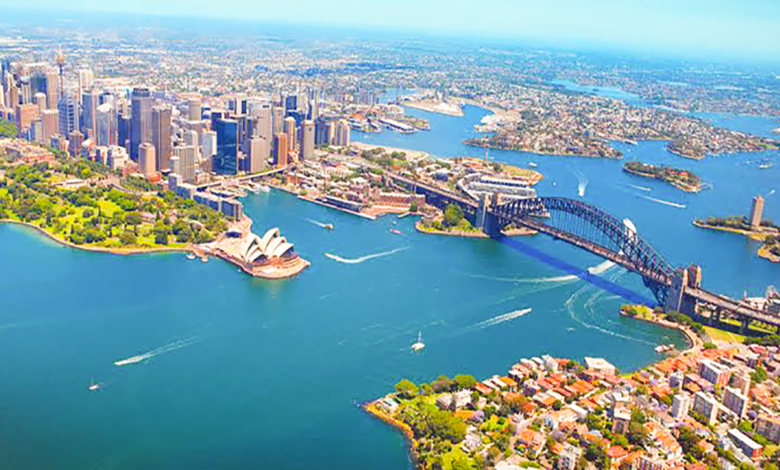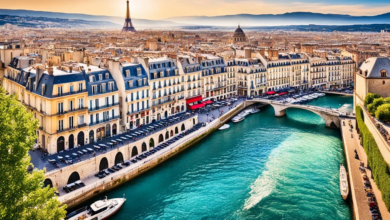Discovering Australia: An Essay on Travel and Tourism

Introduction
Australia, the land down under, is a continent of unparalleled beauty and diversity. From the sunburnt Outback to the vibrant cities and stunning coastlines, Australia offers travelers a unique blend of natural wonders, cultural experiences, and adventures. This essay explores the magic of travel and tourism in Australia, providing a traveler’s guide and insights into fast transport routes between its major cities, all conveyed in a humane and dramatic writing style.
The Essence of Australia
A Continent of Contrasts
Australia’s vast landscape is a dramatic stage where nature performs its most spectacular acts.
- The Outback: The heart of Australia is the Outback, a remote and rugged land where the red earth meets the endless sky. Here, travelers can witness the majestic beauty of Uluru (Ayers Rock), a sacred monolith that rises from the desert floor, glowing in the hues of dawn and dusk.
- The Great Barrier Reef: Off the coast of Queensland lies the Great Barrier Reef, the world’s largest coral reef system. This underwater paradise, teeming with vibrant marine life, invites visitors to dive into its crystal-clear waters and explore a world of breathtaking beauty.
Cities of Culture and Innovation
Australia’s cities are dynamic hubs of culture, innovation, and human creativity.
- Sydney: The iconic Sydney Opera House and the towering Harbour Bridge define the skyline of Sydney, a city that blends natural beauty with cosmopolitan flair. Stroll through the historic Rocks District, enjoy the surf at Bondi Beach, or take a ferry to Manly for stunning coastal views.
- Melbourne: Known for its artistic vibe and cultural richness, Melbourne is a city of hidden laneways, world-class galleries, and vibrant street art. The city’s coffee culture is legendary, and its culinary scene is a melting pot of global flavors.
Indigenous Heritage and Modern Australia
Australia’s soul is deeply intertwined with its Indigenous heritage, a rich tapestry of stories, traditions, and connections to the land.
- Aboriginal Culture: Engage with the world’s oldest living cultures through experiences like the Tjapukai Aboriginal Cultural Park in Cairns or the Kakadu National Park in the Northern Territory, where Indigenous guides share their knowledge and traditions.
- Modern Australia: The contemporary Australian spirit is one of inclusivity and innovation. Festivals like Vivid Sydney and Melbourne International Arts Festival showcase the country’s vibrant cultural landscape.
A Traveler’s Guide to Australia
Planning Your Journey
Australia’s vastness requires thoughtful planning to make the most of your visit.
- Research and Booking: Use platforms like TripAdvisor, Expedia, and Booking.com to research destinations and book accommodations. Consider the seasonal variations; for instance, the best time to visit the southern cities is during their summer months (December to February), while the northern regions are ideal in the winter (June to August).
- Itinerary: Craft an itinerary that balances urban exploration with nature adventures. Include must-see landmarks, hidden gems, and time for relaxation.
Fast Transport Routes
Navigating Australia efficiently is crucial given its size. Here are some key transport routes between major cities:
- Sydney to Melbourne: The fastest route is by air, with multiple daily flights taking around 1.5 hours. For a scenic journey, consider the XPT train or a road trip along the Hume Highway.
- Melbourne to Brisbane: Direct flights take about 2 hours. Alternatively, embark on a road trip along the Pacific Highway, passing through beautiful coastal towns.
- Sydney to Brisbane: A flight takes approximately 1.5 hours. The Pacific Highway offers a picturesque drive, with stops at places like Byron Bay and the Gold Coast.
- Adelaide to Perth: Flights are the most practical, taking around 3 hours. For the adventurous, the Indian Pacific train offers a transcontinental journey through the heart of Australia.
Embracing the Experience
Travel in Australia is about immersing yourself in the moments and stories that the land and its people offer.
- Cultural Sensitivity: Respect the customs and traditions of Indigenous communities. Engage with local guides and support Indigenous-owned businesses to gain a deeper understanding of their rich heritage.
- Adventure and Relaxation: Balance your adventure with moments of tranquility. Hike through the Blue Mountains, snorkel in the Great Barrier Reef, or simply relax on the beaches of the Whitsunday Islands.
Conclusion
Traveling through Australia is a dramatic and enriching experience, a journey that unfolds like a grand narrative filled with captivating landscapes, vibrant cities, and profound cultural encounters. By planning carefully, navigating efficiently, and embracing the spirit of adventure and respect, travelers can unlock the full magic of this extraordinary continent. Australia, with its bound

the incredible diversity of Australia’s Indigenous cultures and their profound impact on the travel experience.
Australia is home to the world’s oldest continuous living cultures, with Indigenous Australians having inhabited the continent for over 65,000 years. When traveling through Australia, visitors have the opportunity to engage with and learn from these diverse Indigenous communities, each with its own rich history, traditions, and connection to the land.
Exploring Indigenous culture in Australia can involve various experiences, such as attending cultural festivals, participating in traditional ceremonies, visiting art galleries showcasing Indigenous artwork, and joining guided tours led by Indigenous guides. These encounters provide a unique perspective on the country’s history, spirituality, and the enduring connection between the Indigenous people and their ancestral lands.
One particularly remarkable aspect of Indigenous culture is the art. Aboriginal and Torres Strait Islander art is renowned worldwide for its vibrant colors, intricate patterns, and storytelling nature. From ancient rock art sites, such as Kakadu National Park in the Northern Territory, to contemporary art galleries in major cities like Sydney and Melbourne, travelers can immerse themselves in the beauty and significance of Indigenous artistic expressions.
Moreover, engaging with Indigenous communities offers an opportunity to understand their deep spiritual connection to the land known as “Country.” Visitors can learn about the Dreamtime stories, which explain the creation of the land and its features, and gain insights into the sustainable practices that have sustained Indigenous communities for millennia.
While traveling in Australia, meaningful interactions with Indigenous people can foster a profound appreciation for their resilience, cultural knowledge, and the ongoing struggle for recognition and reconciliation. These encounters can be transformative, leaving a lasting impact on travelers by challenging preconceived notions and fostering greater respect and understanding.
but the unique and memorable experience of engaging with Indigenous cultures and exploring their rich heritage adds an extra layer of depth and significance to any journey. By embracing the opportunity to learn from and connect with the world’s oldest living cultures, travelers can forge a deeper connection with Australia’s land and its people, creating memories that will endure long after their visit.

When engaging with Indigenous communities in Australia, it is essential for travelers to approach these interactions with respect, cultural sensitivity, and a willingness to learn. Here are some guidelines to respectfully engage with Indigenous communities and learn about their traditions during your visit:
- Educate Yourself: Before visiting Indigenous communities, take the time to educate yourself about their culture, history, and protocols. Understand that Indigenous cultures are diverse and vary across different regions of Australia. Read books, watch documentaries, and explore reputable online resources to gain a foundational understanding.
- Seek Permission and Follow Protocols: Many Indigenous communities have their own protocols and restrictions regarding access to their lands and cultural sites. Prioritize obtaining permission and following any guidelines or restrictions that may be in place. Seek guidance from local tourism centers or Indigenous organizations to ensure that you are respecting any protocols.
- Participate in Cultural Experiences: Participate in organized cultural experiences or activities offered by Indigenous-owned and operated businesses. These experiences may include guided tours, cultural performances, bushwalks, or workshops. By engaging with these activities, you support the local community while learning about their traditions directly from those who practice them.
- Engage with Respect: Approach interactions with Indigenous individuals and communities with respect and an open mind. Be aware that some topics may be sensitive or sacred, and it’s important to avoid prying or intrusive questions. Listen actively, ask questions respectfully, and be open to learning from their perspectives.
- Support Indigenous Artists and Businesses: Purchase artwork, crafts, and products directly from Indigenous artists and businesses. This supports their livelihoods and helps to preserve and promote Indigenous cultural practices. Ensure that the products you purchase are authentic and ethically sourced.
- Follow Cultural Etiquette: Respect cultural etiquette and follow any guidelines provided by the community. This may include not taking photographs or videos in certain areas, not touching sacred objects or artworks without permission, and refraining from sharing sensitive information or stories without consent.
- Be Mindful of the Environment: Respect the natural environment and sacred sites. Follow any instructions regarding waste disposal and minimize your impact on the land. Avoid littering and damaging any flora or fauna.
- Leave No Trace: When visiting sacred or culturally significant sites, remember to leave no trace behind. Take your rubbish with you, respect the environment, and leave the area as you found it.
- Support Indigenous Causes: Consider supporting Indigenous causes and initiatives beyond your visit. This could involve donating to Indigenous-led organizations, advocating for Indigenous rights, or sharing knowledge and awareness about Indigenous issues.
Remember, engaging respectfully with Indigenous communities is an ongoing commitment to understanding, respect, and reconciliation. By approaching these interactions with humility and a desire to learn, travelers can foster meaningful connections while contributing to the preservation and celebration of Indigenous cultures in Australia.

Supporting Indigenous-owned businesses and artists during your visit to Australia is a meaningful way to contribute to their economic empowerment and cultural preservation. Here are some ways you can best support Indigenous-owned businesses and artists:
- Research and Plan Ahead: Prior to your trip, research Indigenous-owned businesses and artists in the regions you plan to visit. Look for galleries, shops, markets, or online platforms that showcase and sell Indigenous artwork, crafts, clothing, or other products. This will help you identify opportunities to support them during your visit.
- Purchase Directly from Indigenous Artists and Businesses: Whenever possible, purchase directly from Indigenous artists and businesses. Seek out galleries, art centers, cultural centers, or markets that are owned and operated by Indigenous individuals or communities. By buying from them, you ensure that a fair portion of the proceeds goes directly to the artists and entrepreneurs.
- Buy Authentic Indigenous Art: Indigenous artwork holds deep cultural and spiritual significance. When purchasing Indigenous art, ensure that it is authentic and ethically sourced. Look for art that comes with a certificate of authenticity or is sold through reputable galleries or Indigenous-owned businesses. Authentic Indigenous art supports the artists and helps to preserve their cultural heritage.
- Attend Indigenous Art and Cultural Events: Explore Indigenous art exhibitions, cultural festivals, and events that showcase the work of Indigenous artists and performers. These events often provide opportunities to meet and engage with artists directly, learn about their creative processes, and purchase their work.
- Respect Intellectual Property Rights: Indigenous art and cultural knowledge are protected by intellectual property rights. Respect these rights by not reproducing or copying Indigenous artwork or cultural expressions without permission. Ensure that the artwork or products you purchase are sourced from legitimate and authorized channels.
- Spread the Word: Share your positive experiences and discoveries with Indigenous-owned businesses and artists with others. Word-of-mouth recommendations, social media posts, and online reviews can help raise awareness and support for their work. Tag and promote their social media accounts, websites, or online platforms to increase their visibility.
- Engage in Cultural Experiences: Participate in cultural experiences and activities offered by Indigenous-owned businesses. This may include guided tours, workshops, performances, or culinary experiences. Not only will you support the local community, but you will also gain a deeper understanding of Indigenous culture and traditions.
- Educate Yourself and Others: Take the time to learn about the significance and history behind Indigenous artwork and cultural practices. Educate yourself about the diversity of Indigenous cultures in Australia and the challenges they face. Share this knowledge with others to promote understanding and appreciation.
Remember that supporting Indigenous-owned businesses and artists is an ongoing commitment. Even after your visit, you can continue to support them by purchasing their products online, connecting with them through social media, or recommending them to fellow travelers. By actively supporting Indigenous entrepreneurs and artists, you contribute to their economic empowerment, cultural preservation, and the recognition of their valuable contributions to Australian society.


